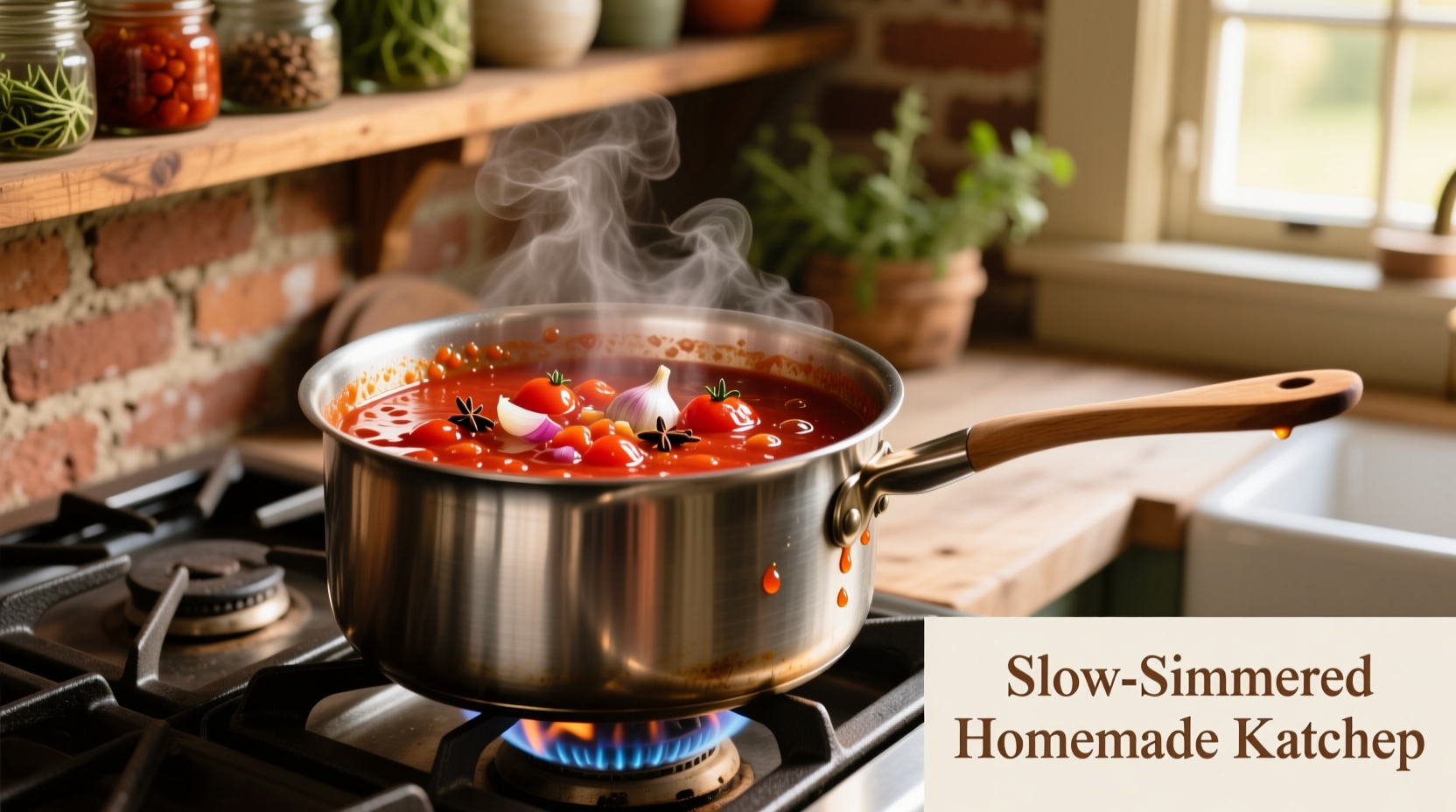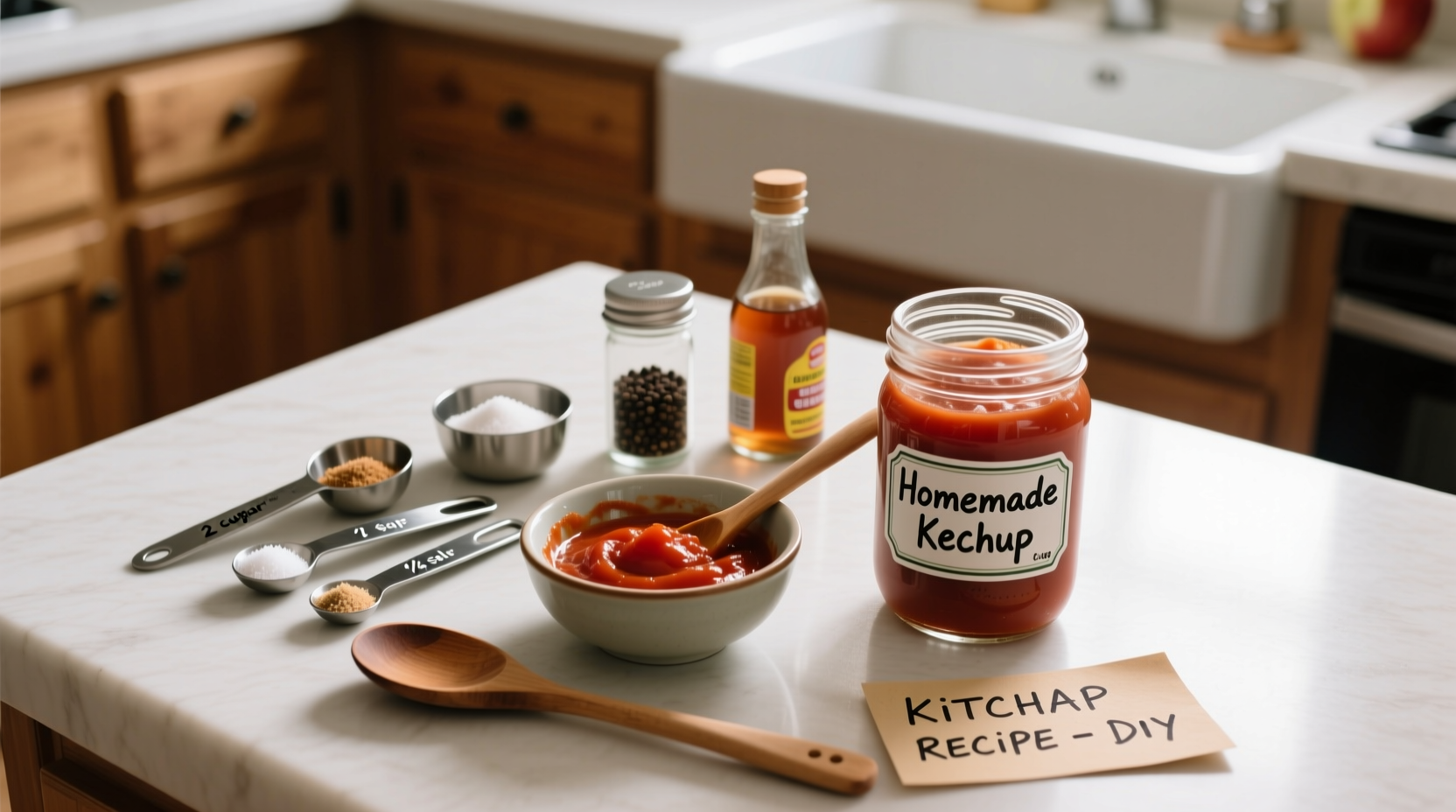Creating homemade ketchup using tomato paste saves significant time compared to traditional recipes requiring fresh tomatoes. This method delivers a rich, customizable condiment ready in under 45 minutes with pantry staples you likely already have. Whether you're making burgers, fries, or specialty sauces, this quick ketchup solution provides superior flavor control without artificial preservatives.
Why Tomato Paste Makes the Perfect Ketchup Base
Tomato paste offers concentrated tomato flavor without the excess water content of fresh tomatoes, eliminating hours of simmering time. According to the USDA's Food Safety and Inspection Service, properly prepared tomato paste-based ketchup reaches safe acidity levels (below pH 4.6) when vinegar is included, making it shelf-stable for short-term storage.
| Commercial Ketchup | Homemade Tomato Paste Ketchup |
|---|---|
| Contains high-fructose corn syrup | Uses natural sweeteners you control |
| Artificial preservatives (potassium sorbate) | Naturally preserved with vinegar |
| Standardized flavor profile | Customizable spice levels |
| 3-6 month shelf life unopened | 1 month refrigerated shelf life |
Essential Ingredients Checklist
Before starting your easy homemade ketchup recipe with tomato paste, gather these pantry staples:
- 1 cup tomato paste (preferably double-concentrated)
- 1/2 cup water (adjust for desired thickness)
- 1/4 cup distilled white vinegar (5% acidity)
- 3 tablespoons granulated sugar (or substitute honey)
- 1 tablespoon onion powder (not onion salt)
- 1 teaspoon garlic powder
- 1 teaspoon fine sea salt
- 1/2 teaspoon mustard powder
- 1/2 teaspoon cayenne pepper (adjust to taste)
- 1/4 teaspoon ground allspice (optional for depth)

Step-by-Step Preparation Process
Mixing the Base
In a medium saucepan, combine tomato paste and water until smooth. Whisk thoroughly to eliminate lumps - this creates the foundation for your simple ketchup substitute using tomato paste. Proper emulsification at this stage prevents separation during cooking.
Adding Flavor Components
Stir in vinegar, sugar, and all dry spices. The vinegar's acidity balances the tomato's natural sweetness while activating the spices. For authentic flavor development, the National Center for Home Food Preservation recommends maintaining a vinegar-to-tomato ratio of at least 1:4 to ensure safe pH levels.
Simmering to Perfection
Bring the mixture to a gentle simmer over medium heat, then reduce to low. Cook uncovered for 20-30 minutes, stirring occasionally. The ketchup is ready when it coats the back of a spoon. This quick ketchup recipe for burgers thickens as it cools, so remove from heat slightly thinner than your desired final consistency.
Troubleshooting Common Issues
Too Thick? Add Liquid Gradually
If your ketchup becomes too thick during simmering, add water or vinegar one tablespoon at a time until reaching your preferred texture. Remember that how to thicken ketchup with tomato paste properly requires patience - it continues thickening as it cools.
Flavor Adjustments
Taste before finalizing and adjust:
- Too sweet? Add vinegar 1 tsp at a time
- Too acidic? Add sugar 1 tsp at a time
- Needs depth? Add 1/8 tsp allspice or smoked paprika
Storage Guidelines for Homemade Ketchup
Properly stored, your homemade ketchup without fresh tomatoes will last:
- Refrigerated: 4-6 weeks in airtight container
- Room temperature: Only during immediate serving
The FDA's Food Code specifies that homemade acidified foods like ketchup should be refrigerated after preparation. Always use clean utensils when serving to prevent contamination.
Flavor Variations to Try
Smoky Chipotle Version
Add 1-2 minced chipotle peppers in adobo sauce and 1/2 teaspoon smoked paprika for a southwestern twist perfect with grilled meats.
Sweet & Spicy Mango Ketchup
Blend in 1/4 cup mango puree and increase cayenne to 3/4 teaspoon for a tropical flavor profile that complements seafood dishes.
When This Recipe Works Best
This how to make ketchup with tomato paste method excels in specific scenarios:
- Emergency condiment needs (pantry staple solution)
- Custom flavor development for specialty dishes
- Teaching children basic sauce preparation techniques
- Creating small-batch test recipes before scaling up
It's less suitable for canning large quantities or commercial production where precise pH monitoring is required. For everyday family use, this approach delivers consistent results with minimal equipment.
Historical Context of Ketchup Evolution
Ketchup's journey from 17th century Chinese fish sauce to today's tomato-based condiment reveals why our homemade ketchup recipe with tomato paste works so well. The 1876 Heinz breakthrough standardized tomato ketchup, but early versions used mushroom or walnut bases. Modern food science confirms that concentrated tomato products like paste provide optimal lycopene availability while reducing preparation time significantly compared to fresh tomato methods.
Frequently Asked Questions
Can I use this ketchup for canning? While safe for refrigeration, this recipe isn't formulated for water bath canning. For shelf-stable canned ketchup, follow USDA-tested recipes with precise vinegar ratios and pH testing.
Why does my ketchup separate? Separation occurs when the emulsion breaks during cooking. Prevent this by maintaining gentle heat and whisking thoroughly when combining ingredients. If separation happens, blend briefly with an immersion blender.
How can I make sugar-free ketchup? Substitute sugar with 2-3 tablespoons erythritol or monk fruit sweetener. Note that sugar contributes to texture, so you may need to adjust liquid content slightly when using alternatives.
Can I freeze homemade ketchup? Yes, freeze in ice cube trays then transfer to freezer bags for up to 6 months. Thaw in the refrigerator before use. Freezing may slightly alter texture but preserves flavor effectively.











 浙公网安备
33010002000092号
浙公网安备
33010002000092号 浙B2-20120091-4
浙B2-20120091-4